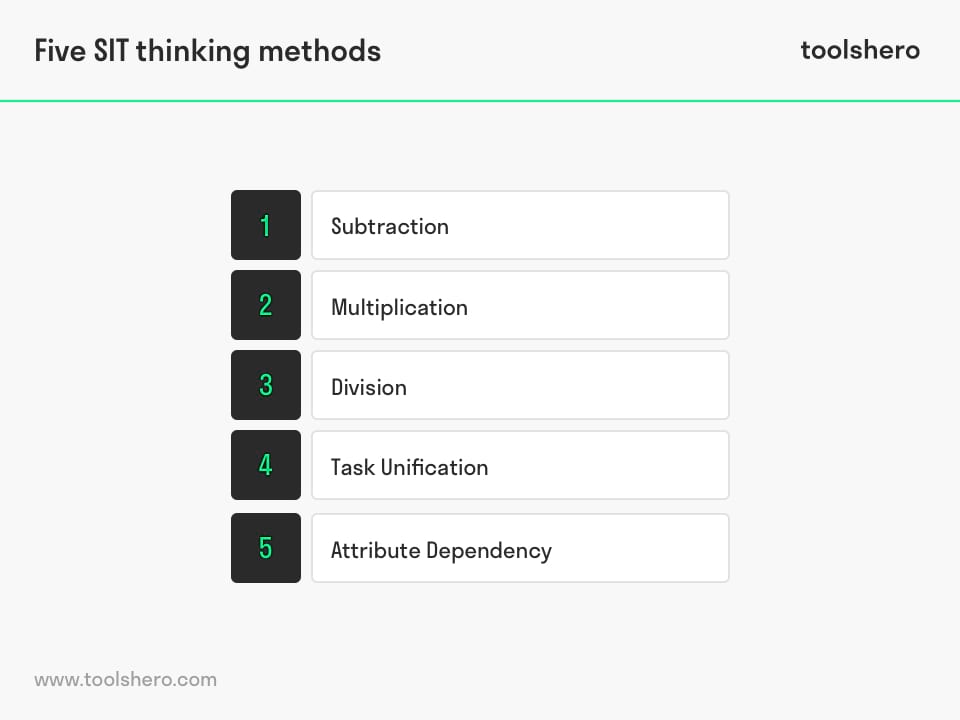Systematic Inventive Thinking (SIT)

Systematic Inventive Thinking: this article explains Systematic Inventive Thinking (SIT) in a practical way. Next to what it is, this article also highlights the topic creativity, the five methods, the five principles and the benefits. After reading, you will understand the basics of this problem solving method. Enjoy reading!
What is Systematic Inventive Thinking (SIT)?
Systematic Inventive Thinking (SIT) is a thinking methodology where creativity takes centre stage. It contains five thinking patterns that humans have used for thousands of years. It directly contradicts the principle of ‘thinking outside the box’ and uses ‘thinking inside the box’ as a guiding principle in order to prove that creativity is not the prerogative of only a few.
Systematic Inventive Thinking (SIT) is also a problem solving and innovation methodology, but it’s mostly known as a methodology for innovation. It offers companies programmes that help with changes and developments in corporate culture, procedures, and innovation practices.
Systematic Inventive Thinking (SIT) was developed in Israel in the 1990s by Amnon Levav, Haim Harduf, Haim Peres, Jacob Goldenberg and Roni Horowitz. SIT is derived from engineering discipline TRIZ, by Genrich Altshuller.
One of Altshuller’s theories was that innovations always show a common pattern. This theory is known as the Theory of Inventive Problem Solving (TIPS). The thinking methodology was developed and grew into the founding of an innovation company with the same name. Systematic Inventive Thinking’s headquarters are located in Tel Aviv, Israel, but it has branch offices spread around the world.
The methodology is also used in universities like Columbia University and London Business School.
Creativity
In the 1970s, researchers from cognitive psychology discovered a method for measuring creativity. This measure was developed with the idea that a creative person is someone who has a flow of ideas.
The number of ideas a person generates in a certain amount of time is indicative of their degree of creativity. Based on that thought, it was then assumed that an increase in the number of ideas would automatically lead to an improvement in quality.
The trickiest part, however, is not the number of ideas a person can generate, but their originality. More recent studies have shown that. A large flow of ideas, then, doesn’t always lead to an increase in the number of original ideas.
These discoveries led to a new approach to organised thinking and designing structured processes, rather than generating separate ideas. This structured approach is at the core of the Systematic Inventive Thinking methodology.
Five Systematic Inventive Thinking methods
Problems are traditionally addressed by brainstorming about them, without any structure whatsoever. Systematic Inventive Thinking does things differently. According to Systematic Inventive Thinking, innovation takes place when:
- Thinkers work within a familiar world;
- Solutions are invented by good ideas that are independent of a specific problem;
- And when the following five methods are used: subtraction, multiplication, division, attribute dependence, and task unification.

Figure 1 – Five SIT methods
Subtraction
This method from the Systematic Inventive Thinking (SIT) methodology involves taking an essential part out of a product or service and giving new life to it. That part was previously considered a crucial component of another product. For example, the idea for a recorder was generated by taking Sony’s Walkman and subtracting the recording function from the total product.
Multiplication
Multiplication involves taking a certain component from a product or service and adding the same component to the whole again several times. This usually involves a component previously thought of as not adding any value.
Division
Division involves taking apart a certain unit and dividing it into small portions. These portions are then adjusted in order to realise a new benefit or to add more value. An example of this is the use of a refrigerated counter. Instead of using a large external refrigerator, a refrigerator drawer can be conveniently installed below the counter.
Task Unification
Innovative products and services are generally collections of certain tasks and activities that are unified within a component. Unification consists of new tasks being assigned to existing sources. An example of this is crowdsourcing. Here, large groups of people are used by having each of them perform a specific task.
Attribute Dependency
Attribute dependency involves uniting two previously independent components and making them depend on each other in a way that adds value. This means that an attribute, or component, within a product can change, while another attribute changes with it. An example of this is sunglasses with photochromic lenses.
Systematic Inventive Thinking: the five principles
In order to be able to carry out the techniques described above in an effective and efficient way, it’s important to understand what SIT is based on. For this reason, Systematic Inventive Thinking (SIT) from Tel Aviv describes the following five SIT principles:
Thinking inside the box
A crucial part of SIT is the closed world. The first principle, and the first important step in SIT, is defining a problem world.
The person solving the problem knows that within that world, all building blocks are available that can be used to find a solution to the problem. This creates focus and a feeling of power and strength, resulting in motivation. By approaching problems in this way, they change into challenging and fun puzzles.
Function follows form
This term was invented by Roland Finke and is considered a reverse process, since the point of departure is the existing resource and not the specific problem or the market demands. In other words, new demands are identified that do not exist yet. These are later introduced to the market.
Qualitative change
The principle of qualitative change assumes that solutions can be found within a situation, and that the core of the problem can be removed. This neutralises the situation, so that there is no longer an obstacle. The previously negative element can even be changed into a positive factor. That way, a disadvantage is turned into an advantage.
Path of most resistance
It is natural to take the easiest route in the thinking process, just as water flows down from mountains along the path of least resistance. With little resistance, however, it gets harder and harder to generate new ideas. This is why SIT stimulates an alternative approach, the counterintuitive path. That is, the path of most resistance.
Cognitive fixedness
Cognitive fixedness is a state of mind in which a situation or object is perceived and observed in a very specific way. In this state, all external elements are shut down. There are various ways of doing this. One way is to view objects as a whole and imagine how the object could be reorganised to make it look different.
Near Far Sweet
Near Far Sweet (NFS) refers to the sweet spot in innovation. Few ideas are turned into applications. They are uninspired or impractical. The NFS principle ensures that the ideas generated are sufficiently far removed from the situation in which they were developed to be interesting to others, yet sufficiently near the core competencies to be feasible.
Benefits of Systematic Inventive Thinking (SIT)
The use of Systematic Inventive Thinking (SIT) provides some clear benefits:
- The ideas are often radical and innovative
- The ideas generated are often checked
- The ideas can actually be implemented
- The SIT methodology is easy to use;
- The methodology is systematic
Now it’s your turn
What do you think? Do you recognize the explanation about Systematic Inventive Thinking (SIT)? Is SIT used in your environment, or do you see value in the use of SIT in the future? How do you think an organisation could organise and improve innovation?
Share your experience and knowledge in the comments box below.
More information
- Barak, M., & Goffer, N. (2002). Fostering systematic innovative thinking and problem solving: Lessons education can learn from industry. International Journal of Technology and Design Education, 12(3), 227-247.
- Barak, M., & Mesika, P. (2007). Teaching methods for inventive problem-solving in junior high school. Thinking skills and creativity, 2(1), 19-29.
- Wang, Y. H., Lee, C. H., & Trappey, A. J. (2017). Modularized design-oriented systematic inventive thinking approach supporting collaborative service innovations. Advanced Engineering Informatics, 33, 300-313.
How to cite this article:
Janse, B. (2019). Systematic Inventive Thinking (SIT). Retrieved [insert date] from Toolshero: https://www.toolshero.com/problem-solving/systematic-inventive-thinking-sit/
Published on: 09/27/2019 | Last update: 04/10/2024
Add a link to this page on your website:
<a href=”https://www.toolshero.com/problem-solving/systematic-inventive-thinking-sit/”>Toolshero: Systematic Inventive Thinking (SIT)</a>












